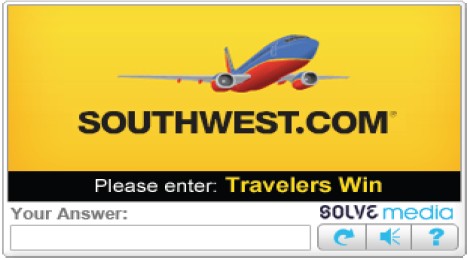What is “native advertising”? A Google search returns 109 thousand hits for a term that is just over a year old. Some credit Union Square Ventures’ Fred Wilson with coining the term in September 2011. Wilson argued at the time that advertising leveraging the native capabilities of a device or medium and fit the content context would elicit higher levels of consumer response.
One example of native advertising, is Solve Media’s form of advertising using Captcha technology. Simply by asking for meaningful, brand message related words versus random words as in the example below drives lift in recall, engagement and purchase intent. Solve Media results in its TYPE-IN ad campaigns show increases in brand awareness (52%), brand association (65%), brand recall (67%), brand favorability (38%) and purchase intent (24%).

In a new white paper released this month by Solve Media, the market for “native advertising” was sized at $3 billion based on a September 2012 survey of 800 media buyers, agencies, creatives, online publishers, venture capitalists, private equity firms and angel investors. As Solve Media put it, “Can marketers change their messages from unwelcome interruptions to a natural, integral part of how people consume information? Better yet, can ad actually add value to the user experience? This is the promise of native advertising.”
There appears to be a discontinuity in the marketplace when it comes to native advertising. Solve Media found that 70% of creatives say the user experience (UX), “is the most important thing in native advertising.” They also found that 57% of private investors would be “likely or very likely to invest in native advertising.” Interestingly, the study also found that while 59% of media buyers say native ads are “very important” and 49% of media buyers “would buy native advertising”; only 14.3% of publishers say they are “very likely” to add a native advertising option.” Buyers in New York, LA, San Francisco and Chicago will be spending the most on native advertising, according to Solve Media. Time to get the buy and sell sides synched up on native advertising.
What is driving the rapid growth of native advertising? Solve Media cites BIA/Kelsey’s social media advertising forecast showing a 19.2% CAGR growth from $4.6B in 2012 to $9.2B in 2016 to make the point that, “the rise of social media has shifted consumers’ expectations of how brands should communicate. They now expect conversation on their timetable and in their terms.”
Native advertising is not as much a new phenomenon as it as a new label for an evolution in advertising. For example, Google AdWords has long leveraged the content and context to add value to the search experience. Ads related to the content of the search are served versus semi-random banner ads.
Solve Media identifies two broad types of native advertising in its white paper: (1) Brand as Publisher (large scale, continuous content creation by the brand); and (2) Brand as intermediary (small-scale, as needed content creation by the brand). “Brand as Publisher” examples include Tumblr Pinned Posts, Radar and Spotlight; StumbleUpon Paid Discovery; WordPress Promoted Videos; Outbrain Amplify; Twitter Promoted Tweets; or Sharethrough. “Brand as Intermediary” examples include Google AdWords; YouTube Promoted Videos; Facebook Sponsored Stories; Solve Media’s own Type-In Captcha; Spotify Branded Apps and Playlists or BuzzFeed Sponsored Image Galleries.
BIA/Kelsey’s view is that native advertising, whether viewed as new name for an existing phenomenon or a true new trend, certainly is part of a larger trend toward more ROI accountability in advertising driven not just by the increasing availability and use of metrics and analytics but more importantly by a suite of new personalization technology powered capabilities including real time bidding; social media engagement and content mass customization and contextualization. The bottom line is that as the user experience is enhanced by more relevant (local, timely, context related) editorial, search and advertising information, we will see increasing lifts in key metrics such as brand lift and purchase intent.
This Post Has 3 Comments
Leave a Reply
You must be logged in to post a comment.

Solve Media’s captchas may be lots of things, but they sure as heck ain’t native. The first two criteria to be native – unique to the site and part of the user’s “native” experience, they don’t satisfy #1 and its debatable if they satisfy #2.
Smells like bandwagon hopping to entice a buyer of your company.
Buy and sell, it’s 100% free online classifieds ads: Apartments, real estate, jobs, cars, Matrimonial, Dating-Romance-and-Miscellaneous, anything!
India Suno online classifieds ads
Hey there! I realize this is sort of off-topic however I had to ask.
Does managing a well-established blog like yours take a massive amount work?
I’m completely new to running a blog however I do write in my journal on a daily basis. I’d like to start a blog so I can easily share my own experience and thoughts online.
Please let me know if you have any kind of recommendations or tips
for brand new aspiring blog owners. Thankyou!